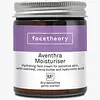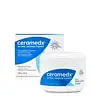What's inside
What's inside
 Key Ingredients
Key Ingredients

 Benefits
Benefits

 Concerns
Concerns

 Ingredients Side-by-side
Ingredients Side-by-side

Water
Skin ConditioningGlycerin
HumectantButyrospermum Parkii Butter
Skin ConditioningGlyceryl Stearate Se
EmulsifyingTheobroma Cacao Seed Butter
EmollientPrunus Amygdalus Dulcis Oil
Skin ConditioningOlea Europaea Fruit Oil
MaskingPropanediol
SolventCetyl Alcohol
EmollientStearic Acid
CleansingPanthenol
Skin ConditioningPrunus Armeniaca Kernel Oil
MaskingDalea Spinosa Seed Oil
MaskingOryza Sativa Bran Oil
EmollientTocopherol
AntioxidantAvena Sativa Kernel Flour
AbrasiveSodium Anisate
AntimicrobialSodium Levulinate
Skin ConditioningSodium Ascorbyl Phosphate
AntioxidantGlyceryl Caprylate
EmollientLactic Acid
BufferingSodium Hyaluronate
HumectantAmorphophallus Konjac Root Powder
AbrasiveCitrus Nobilis Peel Oil 0.485%
MaskingWater, Glycerin, Butyrospermum Parkii Butter, Glyceryl Stearate Se, Theobroma Cacao Seed Butter, Prunus Amygdalus Dulcis Oil, Olea Europaea Fruit Oil, Propanediol, Cetyl Alcohol, Stearic Acid, Panthenol, Prunus Armeniaca Kernel Oil, Dalea Spinosa Seed Oil, Oryza Sativa Bran Oil, Tocopherol, Avena Sativa Kernel Flour, Sodium Anisate, Sodium Levulinate, Sodium Ascorbyl Phosphate, Glyceryl Caprylate, Lactic Acid, Sodium Hyaluronate, Amorphophallus Konjac Root Powder, Citrus Nobilis Peel Oil 0.485%
Water
Skin ConditioningTheobroma Cacao Seed Butter
EmollientPrunus Amygdalus Dulcis Oil
Skin ConditioningPrunus Armeniaca Kernel Oil
MaskingCetearyl Olivate
Cetearyl Alcohol
EmollientButyrospermum Parkii Butter
Skin ConditioningSorbitan Olivate
EmulsifyingGlycerin
HumectantCaprylic/Capric Triglyceride
MaskingPyrus Malus Fruit Extract
Skin ConditioningSorbitan Stearate
EmulsifyingDimethicone
EmollientSodium PCA
HumectantPotassium Cetyl Phosphate
EmulsifyingCeramide NP
Skin ConditioningLecithin
EmollientPhospholipids
Skin ConditioningGlycine Soja Sterols
EmollientLinoleic Acid
CleansingGlycine Soja Extract
Skin ConditioningSodium Hyaluronate
HumectantOryza Sativa Bran Extract
Skin ConditioningCalendula Officinalis Flower Extract
MaskingSambucus Nigra Flower Extract
RefreshingCucumis Sativus Fruit Extract
EmollientArnica Montana Flower Extract
MaskingHedera Helix Extract
AntimicrobialBambusa Vulgaris Extract
Skin ConditioningRosmarinus Officinalis Leaf Extract
AntimicrobialHelianthus Annuus Extract
EmollientAllantoin
Skin ConditioningCitrus Grandis Seed Extract
AstringentTocopherol
AntioxidantLactic Acid
BufferingSorbityl Laurate
EmulsifyingPotassium Sorbate
PreservativeEthylhexylglycerin
Skin ConditioningPhenoxyethanol
PreservativeWater, Theobroma Cacao Seed Butter, Prunus Amygdalus Dulcis Oil, Prunus Armeniaca Kernel Oil, Cetearyl Olivate, Cetearyl Alcohol, Butyrospermum Parkii Butter, Sorbitan Olivate, Glycerin, Caprylic/Capric Triglyceride, Pyrus Malus Fruit Extract, Sorbitan Stearate, Dimethicone, Sodium PCA, Potassium Cetyl Phosphate, Ceramide NP, Lecithin, Phospholipids, Glycine Soja Sterols, Linoleic Acid, Glycine Soja Extract, Sodium Hyaluronate, Oryza Sativa Bran Extract, Calendula Officinalis Flower Extract, Sambucus Nigra Flower Extract, Cucumis Sativus Fruit Extract, Arnica Montana Flower Extract, Hedera Helix Extract, Bambusa Vulgaris Extract, Rosmarinus Officinalis Leaf Extract, Helianthus Annuus Extract, Allantoin, Citrus Grandis Seed Extract, Tocopherol, Lactic Acid, Sorbityl Laurate, Potassium Sorbate, Ethylhexylglycerin, Phenoxyethanol
Ingredients Explained
These ingredients are found in both products.
Ingredients higher up in an ingredient list are typically present in a larger amount.
This ingredient is also known as shea butter. It is an effective skin hydrator and emollient.
Emollients help soothe and soften your skin. It does this by creating a protective film on your skin. This barrier helps trap moisture and keeps your skin hydrated. Emollients may be effective at treating dry or itchy skin.
Shea butter is rich in antioxidants. Antioxidants help fight free-radicals, or molecules that may harm the body. It is also full of fatty acids including stearic acid and linoleic acid. These acids help replenish the skin and keep skin moisturized.
While Shea Butter has an SPF rating of about 3-4, it is not a sunscreen replacement.
Shea butter may not be fungal acne safe. We recommend speaking with a professional if you have any concerns.
Learn more about Butyrospermum Parkii ButterGlycerin is already naturally found in your skin. It helps moisturize and protect your skin.
A study from 2016 found glycerin to be more effective as a humectant than AHAs and hyaluronic acid.
As a humectant, it helps the skin stay hydrated by pulling moisture to your skin. The low molecular weight of glycerin allows it to pull moisture into the deeper layers of your skin.
Hydrated skin improves your skin barrier; Your skin barrier helps protect against irritants and bacteria.
Glycerin has also been found to have antimicrobial and antiviral properties. Due to these properties, glycerin is often used in wound and burn treatments.
In cosmetics, glycerin is usually derived from plants such as soybean or palm. However, it can also be sourced from animals, such as tallow or animal fat.
This ingredient is organic, colorless, odorless, and non-toxic.
Glycerin is the name for this ingredient in American English. British English uses Glycerol/Glycerine.
Learn more about GlycerinLactic Acid is another well-loved alpha hydroxy acid (AHA). It is gentler than glycolic acid but still highly effective.
Its main role is to exfoliate the surface of the skin by loosening the “glue” that holds dead skin cells together. Shedding those old cells leads to smoother, softer, and more even-toned skin.
Because lactic acid molecules are larger than glycolic acid, they don’t penetrate as deeply. This means they’re less likely to sting or irritate, making it a great choice for beginners or those with sensitive skin.
Like glycolic acid, it can:
Lactic acid also acts as a humectant (like hyaluronic acid). It can draw water into the skin to improve hydration and also plays a role in the skin's natural moisturizing factor (NMF) in the form of sodium lactate.
Studies show it can boost ceramide production to strengthen the skin barrier and even help balance the skin’s microbiome.
To get results, choose products with a pH between 3-4.
Lower strengths (5-12%) focus on surface exfoliation; higher strengths (12% and up) can reach deeper in the dermis (deeper, supportive layer) to improve skin texture and firmness over time.
Though it was originally derived from milk, most modern lactic acid used in skincare is vegan. It is made through non-dairy fermentation to create a bio-identical and stable form suitable for all formulations.
When lactic acid shows up near the end of an ingredient list, it usually means the brand added just a tiny amount to adjust the product’s pH.
Legend has it that Cleopatra used to bathe in sour milk to help reduce wrinkles.
Lactic acid is truly a gentle multitasker: it exfoliates, hydrates, strengthens, and brightens. It's a great ingredient for giving your skin a smooth, glowing, and healthy look without the harshness of stronger acids.
Read more about some other popular AHA's here:
Learn more about Lactic AcidPrunus Amygdalus Dulcis Oil comes from the sweet almond, a tree native to Iran. This oil has no fragrance and is non-volatile.
Almonds contain healthy fats, vitamins, and minerals. It is a rich source of Vitamin E, a great antioxidant and skin conditioning ingredient. Sweet almond oil contains fatty acids such as linolenic acid and triglycerides.
The content of sweet almond oil makes it a great emollient; it can help soften and hydrate your skin. Emollients create a barrier over your skin to trap moisture in. Sweet almond oil has antioxidant properties.
Those with an almond allergy should be careful of this ingredient and speak with a professional about using it in your skincare.
This ingredient may not be fungal-acne safe.
Learn more about Prunus Amygdalus Dulcis OilThis ingredient is the oil from the apricot.
Apricot Kernel Oil is an emollient and helps soften skin. This is due to its fatty acid components. Some of these fatty acids include linoleic and oleic acid.
This ingredient also has antioxidant properties from Vitamins A, C, and E. Antioxidants help fight free-radicals. Free-radicals are molecules that may damage your skin cells. Besides being antioxidants, these vitamins provide plenty of skin benefits as well.
Learn more about Prunus Armeniaca Kernel OilSodium Hyaluronate is hyaluronic acid's salt form. It is commonly derived from the sodium salt of hyaluronic acid.
Like hyaluronic acid, it is great at holding water and acts as a humectant. This makes it a great skin hydrating ingredient.
Sodium Hyaluronate is naturally occurring in our bodies and is mostly found in eye fluid and joints.
These are some other common types of Hyaluronic Acid:
Learn more about Sodium HyaluronateTheobroma Cacao Seed Butter comes from the Theobroma cacoa, or Cacao tree. Cacao trees are native to tropical landscapes.
Like other plant butters, Cacao seed butter is an emollient. Emollients help soothe and soften your skin. By creating a barrier to trap moisture in, emollients help keep your skin hydrated.
Cacao seed butter contains antioxidants known as polyphenols. Antioxidants help fight free-radical molecules by stabilizing them. Unstable free-radicals may cause damage to your skin cells. Antioxidants may help with anti-aging.
Theobroma Cacao Seed Butter can be bad for acne prone skin.
Learn more about Theobroma Cacao Seed ButterTocopherol (also known as Vitamin E) is a common antioxidant used to help protect the skin from free-radicals and strengthen the skin barrier. It's also fat soluble - this means our skin is great at absorbing it.
Vitamin E also helps keep your natural skin lipids healthy. Your lipid skin barrier naturally consists of lipids, ceramides, and fatty acids. Vitamin E offers extra protection for your skin’s lipid barrier, keeping your skin healthy and nourished.
Another benefit is a bit of UV protection. Vitamin E helps reduce the damage caused by UVB rays. (It should not replace your sunscreen). Combining it with Vitamin C can decrease sunburned cells and hyperpigmentation after UV exposure.
You might have noticed Vitamin E + C often paired together. This is because it is great at stabilizing Vitamin C. Using the two together helps increase the effectiveness of both ingredients.
There are often claims that Vitamin E can reduce/prevent scarring, but these claims haven't been confirmed by scientific research.
Learn more about TocopherolWater. It's the most common cosmetic ingredient of all. You'll usually see it at the top of ingredient lists, meaning that it makes up the largest part of the product.
So why is it so popular? Water most often acts as a solvent - this means that it helps dissolve other ingredients into the formulation.
You'll also recognize water as that liquid we all need to stay alive. If you see this, drink a glass of water. Stay hydrated!
Learn more about Water